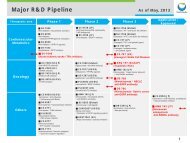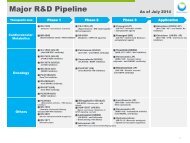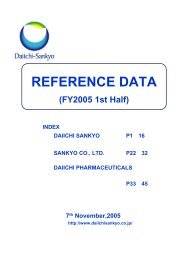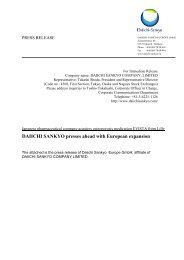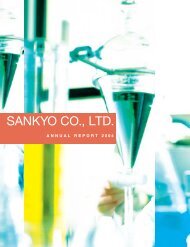Annual Report 2009 - Daiichi Sankyo
Annual Report 2009 - Daiichi Sankyo
Annual Report 2009 - Daiichi Sankyo
Create successful ePaper yourself
Turn your PDF publications into a flip-book with our unique Google optimized e-Paper software.
12.<br />
Net Assets<br />
The Japanese Corporate Law (“the Law”) became effective on May 1, 2006, replacing the Japanese Commercial Code (“the<br />
Code”). The law is generally applicable to events and transactions occurring after April 30, 2006 and for fiscal years ending after<br />
that date.<br />
Under the Japanese laws and regulations, the entire amount paid for new shares is required to be designated as common<br />
stock. However, a company may, by a resolution of the Board of Directors, designate an amount not exceeding one-half of the<br />
price of the new shares as additional paid-in capital, which is included in capital surplus.<br />
Under the Law, in cases where dividend distribution of surplus is made, the smaller of an amount equal to 10% of the dividend<br />
and the excess, if any, of 25% of common stock over the total of additional paid-in-capital and the legal earnings reserve<br />
must be set aside as additional paid-in capital or a legal earnings reserve. The legal earnings reserve is included in retained<br />
earnings in the accompanying consolidated balance sheets.<br />
Under the Code, companies were required to set aside an amount equal to at least 10% of the aggregate amount of cash<br />
dividends and other cash appropriations as a legal earnings reserve until the total of the legal earnings reserve and additional<br />
paid-in capital equaled 25% of common stock.<br />
Under the Code, the legal earnings reserve and additional paid-in capital could be used to eliminate or reduce a deficit by a<br />
resolution of the shareholders’ meeting or could be capitalized by a resolution of the Board of Directors. Under the Law, both<br />
of these appropriations generally require a resolution of the shareholders’ meeting.<br />
Additional paid-in capital and the legal earnings reserve may not be distributed as dividends. Under the Code, however, on<br />
the condition that the total amount of the legal earnings reserve and additional paid-in capital remained equal to or exceeded<br />
25% of common stock, they were available for distribution by resolution of the shareholders’ meeting.<br />
Under the Law, all additional paid-in capital and all legal earnings reserves may be transferred to other capital surplus and<br />
retained earnings, respectively, which are potentially available for dividends.<br />
The maximum amount that the Company can distribute as dividends is calculated based on the non-consolidated financial<br />
statements of the Company in accordance with the Law.<br />
At the annual shareholders’ meeting held on June 26, <strong>2009</strong>, the shareholders resolved cash dividends amounting to ¥28,157<br />
million ($287,316 thousand) by using capital surplus. Such appropriations have not been accrued in the consolidated financial<br />
statements as of March 31, <strong>2009</strong> and are recognized in the period in which they are resolved.<br />
13.<br />
Commitments and Contingencies<br />
(1) Guarantees on Loans<br />
At March 31, <strong>2009</strong>, the Company was contingently liable as guarantors for loans of employees and a certain unconsolidated<br />
company in the amount of ¥3,771 million ($38,480 thousand).<br />
(2) Other Contingencies<br />
Contingent liabilities relating to litigation on certain products’ price control by the Indian government were estimated as ¥2,858<br />
million ($29,163 thousand).<br />
14.<br />
Business Combination<br />
(1) Merger among <strong>Sankyo</strong>, <strong>Daiichi</strong>, and the Company; Reorganization of <strong>Sankyo</strong> and <strong>Daiichi</strong> <strong>Sankyo</strong> Propharma<br />
Pursuant to a merger agreement entered into on November 30, 2006, <strong>Sankyo</strong> and <strong>Daiichi</strong> were merged into the Company<br />
on April 1, 2007.<br />
In addition to that, pursuant to a spin-off agreement between <strong>Daiichi</strong> <strong>Sankyo</strong> Propharma Co., Ltd., a wholly owned subsidiary,<br />
and <strong>Sankyo</strong> entered into on November 30, 2006, the Company spun off the manufacturing operation of former <strong>Sankyo</strong><br />
as to pharmaceuticals and other products on April 1, 2007, and the operation was then contributed to <strong>Daiichi</strong> <strong>Sankyo</strong><br />
Propharma Co., Ltd.<br />
Under the provisions of the Accounting Standard for Business Combination, these transactions were accounted for as a business<br />
combination among entities under common control, and there were no effects on the consolidated statements of the fiscal<br />
year ended March 31, 2008.<br />
(2) Acquisition of U3 Pharma<br />
(a) Description of the business of acquired company<br />
(a) 1) Name and nature of business of acquired company<br />
Name of acquired company: U3 Pharma AG<br />
Nature of business: R&D, mainly in area of therapeutic antibodies for cancer<br />
<strong>Daiichi</strong> <strong>Sankyo</strong> Co., Ltd. <strong>Annual</strong> <strong>Report</strong> <strong>2009</strong> 63




